Hypothermia’s effect
Week 15: April 10-16
Week 15 would prove intense, exhausting and extremely crucial for the 17 returning recruits as they learned vital lifesaving skills that will someday be put to the test. The stakes were high. It was water safety week.
“It’s not a matter of if but when an officer will fall into the water or through the ice,” said Conservation Officer Patrick McManus, recruit school water safety instructor. “As much time as we spend on or near the water, it’s the nature of the job. There will come a day when these recruits will use the skills they learned this week to rescue a victim or themselves.”
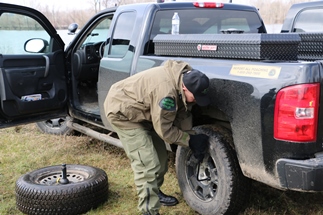 CO McManus, who competed on competitive swim teams in high school and college, brings a high level of expertise to water training in the academy. Under his direction, recruits will spend an intense and productive week participating in many training scenarios preparing them for future situations while on the job. CO McManus, who competed on competitive swim teams in high school and college, brings a high level of expertise to water training in the academy. Under his direction, recruits will spend an intense and productive week participating in many training scenarios preparing them for future situations while on the job.
In pursuit
After Monday morning PT – time in the pool – recruits traveled to a nearby gravel pit. They received instruction on operating patrol trucks, including towing vehicles, changing flat tires, vehicle dynamics and more.
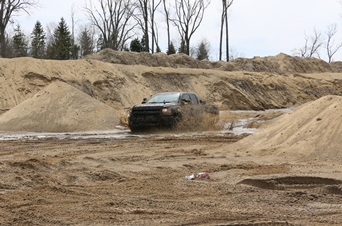 Continuing their training from last week, recruits had more time behind the wheel of a patrol truck as they practiced driving over uneven surfaces, including gravel and sand. Patrol trucks do not operate like a pursuit-rated Michigan State Police vehicle. The recruits learned the difference and adjusted their driving abilities accordingly. With an instructor in the passenger’s seat, recruits pursued an off-road vehicle (ORV) through a course simulating what they might experience while on the job. Continuing their training from last week, recruits had more time behind the wheel of a patrol truck as they practiced driving over uneven surfaces, including gravel and sand. Patrol trucks do not operate like a pursuit-rated Michigan State Police vehicle. The recruits learned the difference and adjusted their driving abilities accordingly. With an instructor in the passenger’s seat, recruits pursued an off-road vehicle (ORV) through a course simulating what they might experience while on the job.
The psychology of it
Recruits spent Tuesday morning in the classroom with Dr. Michael Comer, retired DNR psychologist, for dealing with abnormal persons training. Conservation officers often deal with people having medical, drug or alcohol-related emergencies, and it’s important for the recruits to understand the differences and techniques used for both. “We are often the first call made when someone wanders away from home or becomes lost,” said Sgt. Jason Wicklund, recruit school commander. “Often times, those individuals are affected by psychological disorders, and we need to be able to find them, treat them and get them the help they need.”
 Water safety training begins Water safety training begins
After lunch, recruits reported to “the tank,” the 12-foot deep pool, for the beginning of water safety training. An important component of this training focuses on saving drowning victims who inadvertently pull their rescuers under water.
“Recruits participate in both passive and active drowning victim scenarios,” said Sgt. Wicklund. “Statistics show that more people drown each year trying to rescue victims than the victims themselves. We prepare our recruits with the necessary knowledge and skills necessary to save lives when the time comes.”
On Tuesday, and over the course of the week, recruits learned different swim strokes, removing their clothes to use as floatation devices while treading water, shallow and deep diving, treading water in the dark and more.
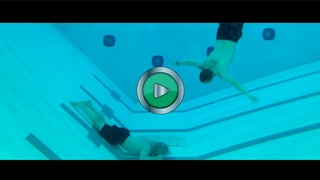 Recruits also learned how to rescue a victim from the bottom of a pool or lake. In this short video, two conservation officers, who also are recruit school staff members, demonstrate a deep water rescue. Recruits also learned how to rescue a victim from the bottom of a pool or lake. In this short video, two conservation officers, who also are recruit school staff members, demonstrate a deep water rescue.
The ice bath
Wednesday afternoon was the ice bath, which simulated hypothermia. Each recruit sat up to their neck in ice water. Heart rate and blood pressure were closely monitored by paramedics through the entire four-minute exercise.
“After one to two minutes in the ice bath, the recruits started experiencing hypothermic effects,” CO McManus said. “They were asked very simple questions throughout the exercise, such as what tests they would be taking during the week and how to phonetically spell their name. They had problems answering these questions.”
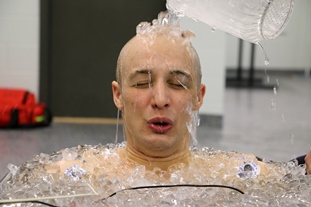 CO McManus noted that in addition to cognitive impairment, physical effects also begin after a couple minutes. “We asked them to make a fist and put their hands up, and it was very difficult for them to do. The ice bath teaches them the effects of hypothermia on the brain and on body movement.” CO McManus noted that in addition to cognitive impairment, physical effects also begin after a couple minutes. “We asked them to make a fist and put their hands up, and it was very difficult for them to do. The ice bath teaches them the effects of hypothermia on the brain and on body movement.”
The exercise also is meant to teach the recruits they can fight through it. “Should this ever happen to them, they now know they can overcome it,” added CO McManus.
See what the ice bath is all about in this short video. (Video is from a past recruit school).
Swimming in uniform
Thursday morning, recruits were back in the pool but this time in full uniform, including gun belts that contained simulated firearms (not the real deal) and boots.
“Recruits were surprised that even in full uniform, they could still float,” CO McManus said.
During this activity, recruits had to take off their uniforms while treading water – not an easy feat – and use them as floatation devices, trapping air inside and tying off the ends of the legs and arms. Then, while still swimming, they had to put their uniforms back on.
“Recruits are learning that they can push through a lot of barriers, no matter what they are,” Sgt. Wicklund said.
Recruits also learned how to escape the grasp of a drowning victim who is pulling them underwater, and then how to re-approach and engage the victim again – always from behind – to get them to safety.
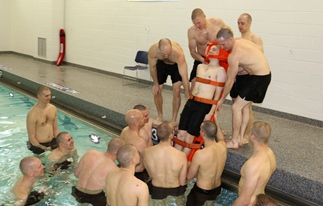 Passive victim scenario Passive victim scenario
The passive victim scenario – rescuing a drowning victim floating face down with a compromised head or neck – was Thursday afternoon. This includes victims who have broken their necks or backs when diving into shallow water. Recruits learned how to properly turn the victim around while supporting the neck and spine and getting the victim to safety without causing additional injury. The trainees also were taught the basics of CPR and first aid. Later in the academy, CO McManus will spend an entire week instructing the recruits on CPR and first aid.
During the exercise, “bystanders” played by conservation officer academy staff frantically yelled for the rescuers to hurry up, and sirens went off. This teaches the recruits to ignore the chaos around them while concentrating on the victim.
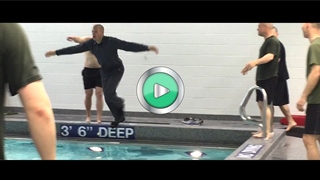 The “bystanders” also attempted to assist, which could compromise the injured victim by moving his injured neck and back. Since conservation officers are trained how to safely move a victim without causing further injury, the recruits practiced transporting the victim to safety unaided using proper methods. View a short video of the passive drowning scenario. The “bystanders” also attempted to assist, which could compromise the injured victim by moving his injured neck and back. Since conservation officers are trained how to safely move a victim without causing further injury, the recruits practiced transporting the victim to safety unaided using proper methods. View a short video of the passive drowning scenario.
Active drowning scenario
The active drowning scenario – a compilation of all the skills learned during the week – took place Friday morning. By the end of the exercise, recruits would be completely, physically exhausted. However, because of this experience, recruits gained confidence that they can fight through exhaustion to save lives.
Each recruit completed the activity alone, while the other recruits waited in closed rooms. The activity began with a good deal of physical exercise – running upstairs, sit-ups, pushups, jumping rope and more. The recruit was then called to “the tank.” Upon entering, the trainee heard sirens and people frantically yelling. A drowning victim was thrashing in the pool. The recruit dove in, swam to the shallow end of the pool and then back to the deep end (to simulate a long swim to get to the victim), engaged the victim and tried to rescue him. However, the drowning victim grabbed onto the recruit, pulling him underwater and keeping him there for a good length of time. The drowning victim grabbed the recruit's arms and legs and wrapped his legs around the recruit.
“At this point, the recruit deployed escape moves and then approached the victim from behind, re-engaging him and towing him to safety,” CO McManus said.
Once at the edge of the pool, the recruit, using his own strength, needed to get the victim out of the water.
“This was a very physical exercise,” CO McManus explained. “Each recruit was pushed to his limit. The goal was to physically challenge each recruit to the point where, by the end of the scenario, he could barely pull himself from the water.”
The recruits had been assessed by CO McManus, Sgt. Wicklund and recruit school staff during the week to evaluate what their individual physical limit would be during the cumulative scenario, and then each recruit was pushed to that limit.
Taxidermy inspections
After an hour of rest to physically recharge, recruits wrapped up the week in the classroom with taxidermy inspections training by CO Jeff Goss, recruit school staff member. Taxidermy is a state-regulated industry, and conservation officers are tasked with making sure state and federal laws are followed correctly.
Recruits were then dismissed for the weekend. Next week, they will learn about evidence collection and engage in more survival-tactics training.
Subscribe to the weekly conservation officer academy blog, which also is posted weekly on the Michigan DNR Facebook page. View past blogs from Recruit School No. 7.
# # #
/Photo details: Accompanying photos are available below for download. Caption information follows.
Drive training.jpg: Off-road driving with patrol trucks was part of the training at a nearby gravel pit.
Vehicle maintenance.jpg: Vehicle maintenance training included changing patrol truck tires.
Ice bath.jpg: Recruits were submerged to their necks in an ice bath for four minutes, during which time they experienced hypothermic effects while their vitals were closely monitored by paramedics. The training was conducted to teach recruits how to fight through and survive the mental and physical effects of hypothermia should they ever fall through the ice.
Compromised victim rescue.jpg: Recruits are trained on proper rescue techniques for drowning victims with neck or back injuries.
Drowning victim rescue.jpg: Rescuing passive or active drowning victims was an important part of training during water safety week. An active drowning victim is a victim that inadvertently pulls the rescuer down or underwater by clinging to them./
The Michigan Department of Natural Resources is committed to the conservation, protection, management, use and enjoyment of the state’s natural and cultural resources for current and future generations. For more information, go to www.michigan.gov/dnr.
|

 CO McManus, who competed on competitive swim teams in high school and college, brings a high level of expertise to water training in the academy. Under his direction, recruits will spend an intense and productive week participating in many training scenarios preparing them for future situations while on the job.
CO McManus, who competed on competitive swim teams in high school and college, brings a high level of expertise to water training in the academy. Under his direction, recruits will spend an intense and productive week participating in many training scenarios preparing them for future situations while on the job. Continuing their training from last week, recruits had more time behind the wheel of a patrol truck as they practiced driving over uneven surfaces, including gravel and sand. Patrol trucks do not operate like a pursuit-rated Michigan State Police vehicle. The recruits learned the difference and adjusted their driving abilities accordingly. With an instructor in the passenger’s seat, recruits pursued an off-road vehicle (ORV) through a course simulating what they might experience while on the job.
Continuing their training from last week, recruits had more time behind the wheel of a patrol truck as they practiced driving over uneven surfaces, including gravel and sand. Patrol trucks do not operate like a pursuit-rated Michigan State Police vehicle. The recruits learned the difference and adjusted their driving abilities accordingly. With an instructor in the passenger’s seat, recruits pursued an off-road vehicle (ORV) through a course simulating what they might experience while on the job. Water safety training begins
Water safety training begins
 CO McManus noted that in addition to cognitive impairment, physical effects also begin after a couple minutes. “We asked them to make a fist and put their hands up, and it was very difficult for them to do. The ice bath teaches them the effects of hypothermia on the brain and on body movement.”
CO McManus noted that in addition to cognitive impairment, physical effects also begin after a couple minutes. “We asked them to make a fist and put their hands up, and it was very difficult for them to do. The ice bath teaches them the effects of hypothermia on the brain and on body movement.” Passive victim scenario
Passive victim scenario The “bystanders” also attempted to assist, which could compromise the injured victim by moving his injured neck and back. Since conservation officers are trained how to safely move a victim without causing further injury, the recruits practiced transporting the victim to safety unaided using proper methods.
The “bystanders” also attempted to assist, which could compromise the injured victim by moving his injured neck and back. Since conservation officers are trained how to safely move a victim without causing further injury, the recruits practiced transporting the victim to safety unaided using proper methods. 




